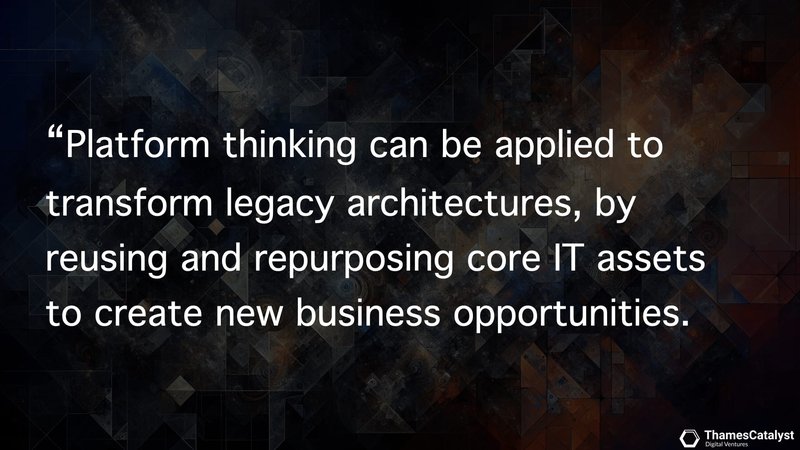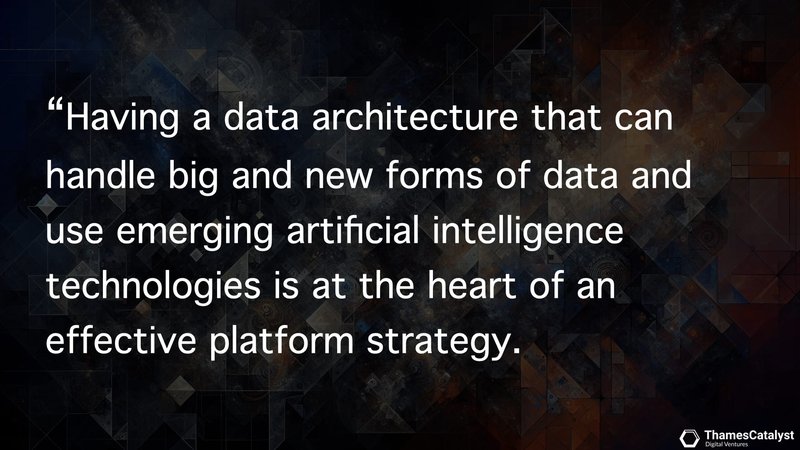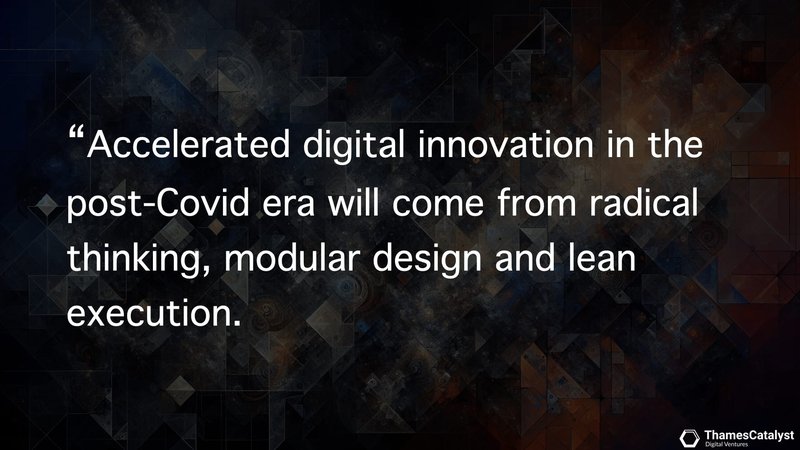Voice: AI-generated courtesy of Qognitive Lab
What are the major characteristics of platform models and how will they influence post-Covid digital innovation? In this article, we unpack five major characteristics of platform business models that, in our opinion, will become cornerstones of digital innovation and success in the post-Covid era.

Covid-19 has been immensely disruptive to businesses and economic models as we know them. There are some differences of opinion, whether this is a real Black Swan – an extreme outlier with catastrophic consequences – or a predictable event, within the realms of probabilistic thinking.
Regardless of how we characterise the current developments, there is little doubt that, in a practical sense, the pandemic will drastically change existing orders in business and economics. One area of particular significance is the impact on digital innovation.
We are at the edge of a big shift. Radical ideas and innovative business models tend to flourish in adverse conditions, while inefficient businesses struggle to recover from economic shocks and dislocations.
In complex systems modelling, this is sometimes described as adapting at “the edge of chaos” – a transition space between order and disorder – through which innovative ideas and stable systems emerge.
Historically, major crises and threats to our economic well-being have been followed by rapid innovation driven by sheer necessity. In order to survive and succeed, one of the areas the businesses must deal with head on is digital competitiveness.
Digital transformation of our businesses and economies was well underway before the pandemic set in. Covid-19 is fast-forwarding that trend at a speed never experienced before. Interestingly, big tech businesses that are built around platform models have prospered and demonstrated their resilience throughout the pandemic.
The so-called FAANG group of companies (Facebook, Amazon, Apple, Netflix and Google) and their Chinese counterparts BAT group (Baidu, Alibaba and Tencent) are epitomes of platform players. Between the global financial crisis of 2007–08 and 2020, these companies developed their dominant market position based on platform strategies that have also proved highly effective in dealing with disruptions caused by Covid-19.
Platform-centric thinking pioneered by these companies was already a dominant and obvious strategy for startups and digital-native organisations. In the post-Covid era, we expect this trend to proliferate even more.
Platform strategy brings together the why, what and how of digital innovation, contrasting old and new ways of approaching business challenges. For digital immigrants with legacy IT assets, it is more complex to define a platform strategy. However, the new economic realities are forcing us to think creatively and to redefine digital transformation, adopting best practices of successful platform players.
So, what are the major characteristics of platform models and how will they influence post-Covid digital innovation? In this article, we unpack five major characteristics of platform business models that, in our opinion, will become cornerstones of digital innovation and success.
We consider some of the common challenges companies face in their digital transformation journeys and think about solutions through the prism of a platform player. Companies from all sectors and sizes can benefit from platform-centric thinking based on these core characteristics.

Platform strategy promotes ecosystems and connectivity
Platform companies thrive on building ecosystems of participants who are attracted by the strong network effects these companies generate through their platforms. These companies often don’t focus on a single product or sell directly to buyers.
Instead, they create marketplaces where buyers and sellers can trade amongst themselves using their platform technology. The more participants the platform attracts, the more valuable it becomes to the participants – thus creating strong network effects.
Platform companies allow partners and developers to build complementary products and services on top of their platforms using development tools such as SDKs (software development kit) and APIs (application programming interfaces).
By allowing third-party developers to build and extend their core platform, companies open up sources of revenue that would be impossible to reach in a closed environment.
Platform thinking is different from product-centric strategy. Often platforms are supersets of individual products developed by either the company itself or its partners. While products are often focused on solving specific problems, platforms organise products in a marketplace with more openness, unlocking new sources of revenue.
It is also the case that platforms and products are sometimes used interchangeably. This is because platforms are relatively new, and often single products have evolved into powerful platforms.
Three main types of platform business models emerged over the last decade: digital match-makers, productivity platforms and innovation platforms.
Consumer transaction-driven platforms are known as digital match-makers – LinkedIn is an example. They connect individuals to other individuals and businesses with a purpose – in the case of LinkedIn, creating professional networking and resourcing opportunities.
Productivity platforms offer business productivity solutions with the benefits of networking and sharing. Github is a productivity platform that facilitates collaboration and sharing in coding, while increasing productivity in software development.
The innovation platforms are infrastructure platforms that provide core technology and foundational support to digital products. Google Cloud Platform (GCP) is a good example of an innovation platform.
For conventional companies that are undergoing digital transformation, having a platform strategy is an interesting framework for innovation. Can their current business model benefit from adding a platform and marketplace?
Often companies have legacy IT assets built over successive generations of technology standards. Platform thinking can be applied to transform legacy architectures, by reusing and repurposing core IT assets to create new business opportunities. Platform thinking can be used to design ways to unlock hidden data assets and monetise them through sharing.
Platforms are light on physical assets
Modern platform businesses often follow an asset-light strategy. Rather than deploying capital to own physical assets such as hotels, taxis, retail spaces or servers, asset-light players prefer to have access to physical assets through pay-as-you-go management or franchise contracts.
They invest more in proprietary digital assets, focusing on the “last mile” customer experience. By concentrating on improving customer engagement through digital innovation, these platforms aim to scale rapidly, which is often difficult when burdened with complex ownership of the whole value chain.
From an investor’s perspective asset-light strategy is a clear favourite. According to a recent McKinsey study on startup funding in the logistics industry, the majority of funding in recent years has been raised by tech-focused startups offering last mile delivery services to retailers and individuals, despite this being a smaller addressable market compared to the whole logistics sector.¹
More-established firms that have pivoted heavily towards building last mile technologies and integrating them with the supply chain have been rewarded by the market. For example, UK-based online supermarket Ocado, with its e-commerce platform focusing on last mile optimisation, is considered to be more like Amazon and less like other large UK grocers, and is valued as such.
For startups, being asset-light is normally not an option – it’s the only viable way. Today’s startups tend to rely on cloud-based data and computing services rather than deploy scarce resources to buy servers or data centres, unless providing infrastructure is their core business proposition.
There are a lot of similarities in following an asset-light strategy and being a lean startup: essentially that mindset and cultural bent is what drives a successful platform strategy and digital transformation.
Many legacy companies, especially large banks with their complex IT assets, sometimes find it hard to untangle the complex web of interdependencies. Focusing on the last mile experience can bring clarity of purpose to their platform strategy.

Platforms are data driven
Some of the most valuable companies in the world such as Amazon, Facebook and Alibaba are built around platforms that utilise consumer-generated data.
According to one study by the European Commission, the value of the data economy, which measures the overall impact of the data sold as a product or service on the economy as a whole, exceeded the threshold of 400 billion euros in 2019 for the EU27 plus the United Kingdom.²
In order to compete, businesses are challenged not only to effectively manage their own data from traditional sources but also to gather insights from the vast amounts of alternative sources of data that are currently available.
Bringing structured and unstructured data together at scale in a meaningful way to drive business insights remains challenging for companies with legacy data architectures. This is a continuously evolving area in terms of both challenges faced and solutions offered.
There are cloud-based solutions, such as data warehouses and data lakes, that companies can deploy to centralise their data assets and build decision analytics on top.
Data warehousing is the traditional approach where companies aggregate vast amounts of data in a highly structured way so that it can be relied upon by users as the “single source of truth”.
However, the requirement to maintain a rigid schema adds inflexibility when dealing with semi or unstructured formats from alternative data sources such as websites, mobile apps, social media, audio/video, streaming data from applications and connected devices.
Data lakes take a “store first, curate later” approach, enabling the storage of vast amounts of raw data without imposing a data structure or schema at the point of entry. In this case, data scientists, developers and business analysts first explore the raw data for latent insights using various processing tools and then apply a governed data-discovery process to the enquiries that prove to be beneficial for decision-making.
Data lakes can underpin modern big data analytics, helping to break enterprise data silos; however, if not designed correctly, a data lake can quickly turn into an unmanaged data swamp.
Data strategy is intricately linked to the ability to incorporate artificial intelligence, machine learning and deep-learning techniques into data-driven decision-making. Platform companies are early adopters of big data analytics powered by AI tools.
Having a data architecture that can handle big and new forms of data, and use emerging artificial intelligence technologies, is at the heart of an effective platform strategy.
Platforms thrive on modular design
Modern platforms are characterised by modular design, which gives them a powerful competitive advantage. Many enterprise applications from the early days were built on monolithic architectures that wrapped up all the business functionalities and underlying source-code into a single executable or deployment package.
This design approach made enhancements and upgrades challenging, as even minor changes could break mission-critical functionalities. A monolithic architecture thwarts innovation, as the change process is both time consuming and expensive.
Enterprises often have multiple instances of legacy monolithic applications for different business functions, which are then connected through a middleware communication system often known as the enterprise service bus (ESB).
Applications talk to each other through the ESB, avoiding point-to-point integration. This is known as service-oriented architecture (SOA). However, this approach does not fully address the inherent challenges with monolithic applications.
Such applications do not mitigate the risk of the communication hub itself becoming a single point of failure for the entire enterprise. We can start to imagine how legacy architecture and technology infrastructure can stand in the way of change and innovation.
In contrast, many modern platforms are built on the modular design of small independent services – known as microservices – that communicate through well-defined application programming interfaces (APIs).
Each service performs a single business function or application process, and it does it well. Microservices architecture is built on loosely coupled and distributed services, which removes the risk of one single service failure bringing down the entire platform.
This allows for continuous iteration and production deployment by independent teams working with the technology stacks that most suit the business functions they are servicing. Microservices communicate with each other through APIs that are agnostic to the technology stacks of the services.
Platform strategy for organisations with monolithic applications can involve breaking up these applications into suites of independent microservices that run on lightweight containers in the cloud and communicate through APIs.
This not only enables the sharing of data and functionalities in a more robust and agile way, but also allows partners and external users to access these resources, thus creating new sources of revenue and business opportunities.

Platforms need cross-functional teams
Platforms flourish when all the components work together, giving their customers a highly integrated experience.
Platform teams are cross-functional; they bring together business, data, analytics, technology and other necessary expertise under a single cohesive unit with clearly defined business goals.
Innovation demands a culture of intelligent risk-taking and a confluence of cross-functional ideas and expertise. Platform teams can drive continuous, business-led innovation by reducing external dependencies and cutting through organisational silos.
In contrast, many companies with legacy organisational structures have teams built around single functions, such as operations, development, support, etc.
These teams are often highly experienced and focused on their own department or function; however, this often means that they are cut off from or indifferent to teams in other functions, and consequently they do not feel ownership for the overall business objectives.
When teams are siloed, they become risk-averse and operate within their narrowly defined remits, which causes rigid mindsets to form.
Although these shortcomings are well understood, implementing radical change in a mature organisation is challenging. Many large organisations have adopted DevOps, Agile and Lean practices to break organisational silos and mitigate delivery risk in software development and maintenance.
At the heart of these practices lies an organisation’s desire to implement continuous, iterative and incremental change, thus moving away from the big-bang, waterfall approach that dominated change philosophy prior to the platform era.
Under a DevOps model, development and operations teams come together with the goal of achieving continuous integration and continuous delivery (CI/CD) in their application suites.
However, the real test is when we can take these principles outside of software development and apply them to broader business contexts. In order to innovate, organisations need a pro-risk culture where teams can experiment and fail safely within acceptable risk thresholds.
If organisations are to tackle emerging competitive challenges head on, they need to behave almost like a lean startup. This is why many large organisations are setting up innovation labs where cross-functional teams can work together from ideation to production release as cohesive units.
DevOps teams make mature organisations more efficient; platform teams lead innovation.

How can we accelerate innovation?
Many of today’s successful platform companies were startups and relative unknowns during the financial crisis of 2007–08. It would be safe to think that some of the would-be leaders of the coming years are sowing the seeds of their success right now, in the middle of a global pandemic.
They will be the radical thinkers with disruptive business models. Their platforms will be cloud-native with modular microservices architecture, and their data assets and services will often be shared through APIs.
These new platform ventures are already fuelling the growth of “the API economy”; there are over 23,700 public APIs in October 2020, with more than 2,000 being added every year.³ The APIs can disrupt how businesses share data and services, which opens up a whole new set of opportunities.
This has been accelerated in certain sectors by favourable legislation that has forced major players to share their customer data to third parties through APIs – for example, Open Banking initiatives in the UK or PSD2 in the EU.
In the years to come, API-driven platforms are expected to disrupt traditional business models and create many more new opportunities.
Whereas the first generation of platform companies was primarily known for consumer-facing platforms, the second generation of platforms has the potential to go deeper and digitally transform the economic value chain in many sectors.
Covid-19 has presented us with a future that is radically uncertain, and it calls for radical thinking in the way we prepare our businesses for emerging challenges. Our vision for the future, design of our systems and execution of our plans need to adapt to the new reality.
Accelerated digital innovation in the post-Covid era will come from radical thinking, modular design and lean execution.
How can your business benefit from a platform-based strategy?
Reach out to us today and let's explore the possibilities together.
Start a conversationReferences:
- McKinsey and Company (28 May 2020). Startup funding in logistics: New money for an old industry? [online] Available at: <https://www.mckinsey.com/~/media/mckinsey/industries/travel%20transport%20and%20logistics/our%20insights/startup%20funding%20in%20logistics/startup-funding-in-logistics-new-money-for-an-old-industry.pdf> [Accessed 22 September 2020].
- European Commission (2020). The European Data Market Monitoring Tool – Key Facts & Figures, First Policy Conclusions, Data Landscape and Quantified Stories [online] Available at: <https://ec.europa.eu/digital-single-market/en/news/european-data-market-study-update> [Accessed 22 September 2020].
- ProgrammableWeb. http://www.programmableweb.com [Accessed 22 October 2020].